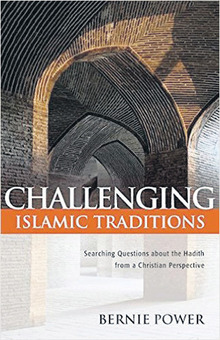‘Perfectly preserved’ Qur’an and Hadith?
Islamic missionaries often claim that the Qur’an has been miraculously preserved from alteration, and that its text is exactly the same throughout the world.
Anthony McRoy

TEXTUAL CRITICISM AND QUR’AN
MANUSCRIPTS
By Keith E. Small
Lexington Books. 244 pages. £21.95
ISBN 978 0 739 177 532
CHALLENGING ISLAMIC TRADITIONS:
Searching Questions about the Hadith from
a Christian Perspective
By Bernie Power
William Carey Library. 296 pages. £16.42
ISBN 978 0 878 084 890
Small’s book, based on his PhD thesis, demonstrates that both claims are questionable and are mainly recent: ‘… early and medieval Islamic scholarship was quite free in its recognition of textual variation and missing portions of the Qur’an, and did not tend to make claims of perfect transmission. Also, study of ancient Qur’anic manuscripts confirms the flexibility described in the earlier ages of Islamic scholarship’ (p.7).
Cairo text 1924
Unlike the modern Greek New Testament, which is a critical text based on a comparison of extant manuscripts, early Syriac, Coptic and Latin translations, as well as quotations by Early Church Fathers, ‘there has never been a critical text of the Qur’an based on extant manuscripts, as has been done with other sacred books and bodies of ancient literature’ (p.3). Rather, ‘The current printed texts of the Qur’an are based on medieval Islamic tradition instead of the collation and analysis of extant manuscripts.’
In fact, the prevalent Qur’an edition used globally today is the 1924 Cairo text: ‘This printed copy was one completed under the patronage of King Fu’ād I of Egypt (r. 1917–1936). This text has become a “standard version” in that it has come to be widely printed throughout the Muslim world.’ (p.170). While the Roman State had no involvement in the compilation of the New Testament, the political involvement and motive for the 1924 Qur’an is significant: ‘This was done under the authorisation of the Egyptian Government of King Fu’ad I to assert Egyptian Islamic leadership in the wake of the fall of the Ottoman Empire after WWI.’
Oral tradition
Apart from the very late dating of this edition, it is noteworthy that ‘it was not taken from actual manuscripts of the Qur’an, but was reconstructed from the written records of oral tradition of what this reading originally consisted.’ Of course, if one text is de facto canonised, to the effective exclusion of others, it is no wonder that it can be claimed that the Qur’an is the same everywhere – since only one edition is used! Most people are unaware of this fact.
Stability but intentional changes
Such is the integrity of Small’s scholarship that he can acknowledge the general stability of the Qur’anic text over the centuries (p. 173), and most variants are unintentional copyist errors. Every ancient text faces this problem. However, he also observes intentional changes in some manuscripts, (p. 135ff). Nothing is of major significance, but the claim of perfect preservation cannot be upheld.
The major problem with Small’s work is that, although accessible and clear, it has too many technical features for anyone other than local church leaders. Perhaps readers could prevail upon the author and the publishers to produce a popular version for the ordinary man or woman in the pew.
The Qur’an needs the Hadith
Islam is not based just on the Qur’an, but also on the Hadith – the narrations of Muhammad, the theme of Power’s book.
Any attempt to dispense with the Hadith, as in ‘Qur’an-only’ movements, is dismissed as heresy (p.30 n48). For example, the Qur’an tells people to pray (i.e. ritual worship – Salat), but only the Hadith tells Muslims how: ‘When someone suggested to Imrān bin Husayn, a Companion of the Prophet, that the Hadith was unnecessary, his reply was sharp: “Indeed you are an idiot, do you find in the Book of God prayer explained!? Do you find in it fasting explained!? Indeed the Quran ordains this, but the Sunna explains it.”’ (p.28).
Power comments: ‘… the Qur’an cannot stand by itself – extra information is needed. This gap is filled by the Hadith ... Each hadith… consists of an isnad, or chain of witnesses, usually back to Muhammad, and a matn, or content…’ (p. xvi-xvii). However, the base of information is not large: ‘The Hadith collections did not have a wide base of contributors. 60% of al-Bukhāri’s Hadith came from only four individuals, and 17 narrators provided 83% of its content…’ (p. 113).
Historical context
The Hadith provides us with the historical context of the Qur’an – including how Muhammad was called to be a prophet, and how the Qur’an was compiled after his death by Caliphs Abu Bakr and Uthman: ‘…the Hadith explains Qur’anic verses, outlining the asbāb ul-nuzūl, or occasions of revelation’ (p.41). The problem here is twofold.
Firstly, there are conflicting Sunni and Shi’a collections, giving sometimes contradictory information: ‘Due to their different assessment of early Islamic history, Shi’a Muslims do not recognize the primacy of the Sunni collections’ (p.11).
Secondly, the late dating of the compilation: ‘The generally accepted Hadith collections were not compiled until 200 or more years after the death of Muhammad’ (p.17). Moreover, other factors intensify this problem: ‘If transmission and editorial inconsistencies were occurring at this early stage, it could throw doubt on the preservation of Muhammad’s actual words as they were committed to writing. This doubt must be compounded by the relatively large time gap between Muhammad’s death in AD 10/632 and the earliest available manuscripts of his sayings… Crone claims that the extant primary sources are from 150 to 300 years after the events which they describe’ (p.98).
Contradictory memorisations
Muslims often retort that hadiths were memorised, but even if true (and we only have the Hadith itself to claim for this) there was no control agent – no extant material against which to judge its preservation at each stage of the chain. Also, how come Sunnis and Shi’a ‘memorised’ contradictory collections? Sunnis and Shiah pray in slightly different ways because of their different Hadith collections – this has led to fatal consequences for Shiah civilians encountering Islamic State jihadis in Iraq.
Powers observes: ‘Some Hadith appear to contradict others, suggesting either an inconsistency on the part of Muhammad or a variety of irreconcilable sources. The existence of such discrepancies within the matn of the Hadith has generated a branch of Islamic scholarship called mushkil al-Hadīth (literally “difficult [things] in the Hadith”) or sometimes mukhtalif al-Hadīth (literally “conflict in the Hadith”).’ (p.47).
Historical certainty?
Further, how can there be any historical certainty about how the Qur’an emerged, if we have to rely on the Hadith – compiled two centuries later – for this information? Further still: ‘Nor have these collections come down in a single unchallenged edition. AlBukhari’s text, for example, “exists in several ‘narrations’ (riwayat...”’ (p.9). As with the Qur’an, there has also been political involvement: ‘… court patronage by both the Umayyads and Abbāsids for the hadith collectors and even hadith fabricators’ (p.11). As for the historical veracity of the isnads: ‘Some of the first collections of the Hadith suffered from a lack of clear isnads back to the prophet and were rejected by succeeding generations. Later collections included complete isnads, but with the passing of time it became easier to fabricate such links...’ (pp.13-14). Powers quotes the famous scholar of Islam, Alfred Guillaume, on this: ‘Isnādic studies have brought the authenticity of the Hadith into question. Typical of this approach is the comment by Guillaume: “Of the resultant mass of tradition few can be confidently regarded as emanating from the authorities whose names they bear.”’ (p.106).
Aids to evangelism
There is much more in Powers’ book, including contrasts with biblical teaching and scientific problems in the Hadith (necessary because Muslims often make extravagant claims of ‘scientific miracles’ in both the Qur’an and the Hadith). Being very accessible, easily comprehensible, any church member should obtain it.
Both books should be acquired by local church leaders, to aid congregational evangelism and to help younger members at colleges and universities facing large, missionary-activist Islamic Societies who make claims for the Qur’an and the Hadith which these books by Small and Powers show to be lacking historical credibility.


